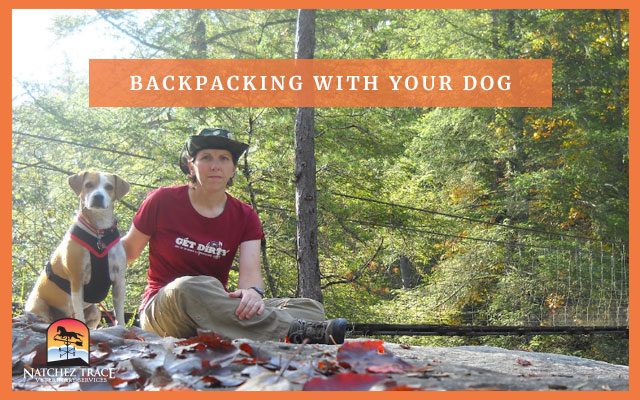What to Know About Taking Your Dog Backpacking
If you already think backpacking is a great way to spend a few days, taking your dog backpacking only adds to the enjoyment. You end up experiencing nature and the wild in a whole different way when you go backpacking with your dog. Here are some things to think about when planning your trip with your best companion.
Pre-Trip Check
A few of the first things to think about have to do simply with responsible dog ownership. These are things you have probably already done, but if you have not, then you really should:
- Spaying and/or neutering – reduces the urge to roam
- Microchipping – makes reuniting you and your dog faster, easier, and simply possible should you become separated
- Basic training – good recall in a dog can save you trouble and heartache when you’re out in the wild where you may need to have verbal control over your dog
- Vaccinations – are they up-to-date? If you’re not sure, call your vet and check. Vaccinations help keep your dog safe
- Physical shape – is your dog in good physical condition for several days of long or strenuous hiking?
A Word on Physical Conditioning
Most dogs seem to have endless amounts of energy – they go and go and go! And frankly, they were made to do just that – travel miles and miles in a day to find food, shelter, companionship. But that is a dog in its purest form. Some of our dogs these days don’t get even close to the amount of daily exercise they should. So consider your dog’s physical shape before you decide if you should take your dog backpacking.
If you really want to include your dog in your trip, spend some time getting them into shape. Start with daily walks for about an hour and build slowly over weeks from there. Make sure you always have water and snacks for them on these training outings. Try to include a variety of terrains so your dog gets comfortable walking on dirt, mud, rocks, etc. This will toughen his paw pads as well as give him a good workout. Never push your dog to go further or faster than is comfortable for him.
Water Crossings and Your Dog
How does your dog feel about water? Is he ok with it, loves it, or is he wary or even frightened of it? These are things you want to know well before your trip, not when you’re 15 miles from the trailhead standing on the banks of a rushing stream! Find a place near home where you can test the waters – so to speak – with your dog. See how they react. Cross the water several times. Never practice crossing a dangerously rushing river – in fact, if you encounter this on your trip, consider your options before crossing any dangerous water.
Packing
Ok, you and your dog are in great shape and you’re ready to plan your backpacking trip and get out there! Here are some tips on what to pack for your dog and how to carry it.
The best idea for most backpackers is to keep it light. Only take what you need. The same holds true for your dog – although in many ways, dogs are like kids and you want to be sure they have everything they need to be happy and healthy on the trail.
Some things to remember to take with you when backpacking with your dog include:
- Food – a good rule of thumb is that your dog will eat about double on the trail what he eats at home. You could check with your vet to get some input on the right calorie consumption for your dog based on the activity levels you’ll achieve on your trip.
- Remember to bring snacks and treats too. These will help your dog maintain energy on the trail in between meals. They may also come in handy should you need to reward or entice your dog to listen to you during the trip.
- Safely store your dog’s food and treats up and away from animals and vermin just as you would your own while on the trail. Don’t feed your dog near your tent and don’t bring dog treats into your tent.
- Water – one of the heaviest items you’ll carry, so check to see what sources of water are available along your route. If there is plenty of water available from rivers, lakes, streams, then you won’t have to pack in as much. Realistically when you’re choosing a trail to pack, especially when you’re taking a dog along, you should choose one with good water sources and avoid dry trails or unknown conditions.
- Contrary to what you may think, you do need to filter and/or treat your dog’s water just like you do your own. Dogs can get just as sick as we can from water contaminated with microorganisms, bacteria, and viruses. You will filter your water, so make sure you filter theirs. Gravity filters are excellent for filtering a lot of water fast and with minimal effort.
- Contrary to what you may think, you do need to filter and/or treat your dog’s water just like you do your own. Dogs can get just as sick as we can from water contaminated with microorganisms, bacteria, and viruses. You will filter your water, so make sure you filter theirs. Gravity filters are excellent for filtering a lot of water fast and with minimal effort.
- Collapsible food and water bowls – highly packable, lightweight, and there when you need them.
- First Aid Kit – you can make up a specific kit for your dog or just ensure that your kit has enough supplies for the both of you and whatever extra supplies you need for your dog. Don’t forget the tick remover and the antihistamine!
- Paw-health is a key factor on the trail as well. Check your pet’s paws frequently to see that they are not cut or cracked. Bring along some paw cream just in case and a towel that you can wet down each night to wipe off dirt and mud from the day’s hike.
- Dog boots may be a good idea too, depending on the terrain and weather you will likely encounter. Not every dog’s favorite accessory, if you think boots are appropriate for the trip, practice having your dog wear them well in advance.
- Dog boots may be a good idea too, depending on the terrain and weather you will likely encounter. Not every dog’s favorite accessory, if you think boots are appropriate for the trip, practice having your dog wear them well in advance.
- Collar with ID – even if your dog is chipped a collar and ID tag are a must. Be sure the ID tag has current information including your cell phone number and the number of someone back home.
- Insect repellant – whatever type of insect repellent you use for your dog, be sure you’ve applied it for this trip. Consider bringing an all-natural spray on for your dog as well for spot treatments on the trail.
- Poop bags and trowel – again, just like your waste, you need to properly dispose of your dog’s waste on the trail. Either carry it out in poop bags or use your trowel to bury it.
- Brush – trail grooming will help keep dirt and bugs out of your tent and off your dog. It will also help your pup stay more comfortable on the trail.
- Proof of vaccinations – just in case. Some parts may require this before letting you set off with your dog into the wild.
- Sleeping bag/pad – the best place for your dog to sleep at night is in your tent with you. This will keep him safe from wandering off or from encountering wild animals. In the tent, have a spot for him with a familiar blanket or dog bed. Sounds heavy and cumbersome, but there are dog beds out there that are lightweight and very packable.
- Warm coat or cool coat – depending on the weather a coat of some kind may be necessary. Carrying one just in case is a good idea. Cool coats are ones that you soak in water and then put on your dog. These help to keep your dog cool throughout the day.
Dog Packs – Can’t My Dog Carry His Own Stuff?
In a word, yes, your dog can carry his own gear. This requires a dog pack. There are several “pros” to having your dog wear a pack. The first is that it will make your pack a bit lighter. A pack also acts as a harness. On the trail, harnesses are probably better than collars and more comfortable for your dog if he is on a leash. Some dog packs include hydration bladders which are an easier way to carry water.
Watch the weight of your dog’s pack, however. You don’t want to overburden him. Younger healthy dogs can carry about 25% of their own body weight. That’s a good place to start. Some dogs will be able to carry more, some much less. Either way, practice and test this out before going on your backpacking trip.
Make sure your dog is properly fitted for his pack. You’ll want to measure his girth, just behind his front legs with a tape measure. Most packs will come in a variety of sizes and be somewhat adjustable. Packs vary in size, style, and capacity.
Contingency and Emergency Plan
What will you do if your dog gets hurt or sick on the trail? We don’t like to think about such things, but we need to. Could you carry out your dog if you need to? Will you have cell phone coverage so you can call for help? If not, what will you do? Think about it. The answer is going to be different for everyone reading this article.
Remember to check in with a ranger if you are in a park or state or national wildlife area. Let them know your trip plan and that you have a dog with you. If you’re late returning because of injury to your dog or to yourself, they will know where to look for you.
Trail Etiquette
As always, be sure that having your dog along on your backpacking trip doesn’t negatively affect anyone else on the trail or the trail itself. Pick up after your dog and pack it out or bury it. Maintain control of your dog. If leashes are required, then keep your dog leashed. Don’t let your dog chase or disturb wildlife. If dogs are not allowed on certain trails, stay off them and pick another trail.
Backpacking with your dog can be a lot of fun – for you and for your dog. Remember to plan your trip
well and follow all the safety precautions for your dog that you would for yourself. Have fun out there.







